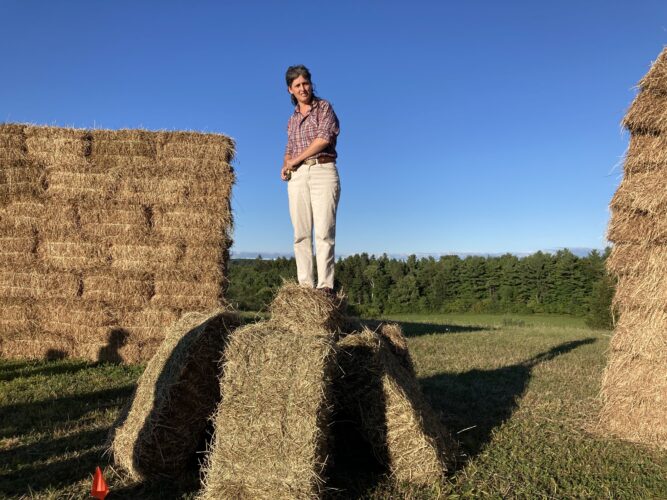
A conversation with Anna Ialeggio
Join us Friday, June 2, 7-8:30pm to bid 2 DIFFRN'T HAYSTACKS adieu! Art Historian Kelly Presutti will discuss learning to see landscapes, what they say about desire, and how Ialeggio's work can make us see Monet differently. Meet Kelly and Anna at this free happening!
2022 Visiting Artist Anna Ialeggio talks with Artistic Director Sayward Schoonmaker about their sculptural/performative work 2 DIFFRN’T HAYSTACKS installed and performed on the grounds in summer 2022. Below is an excerpt from the conversation about Anna’s work, artistic process, and the craft of clowning.
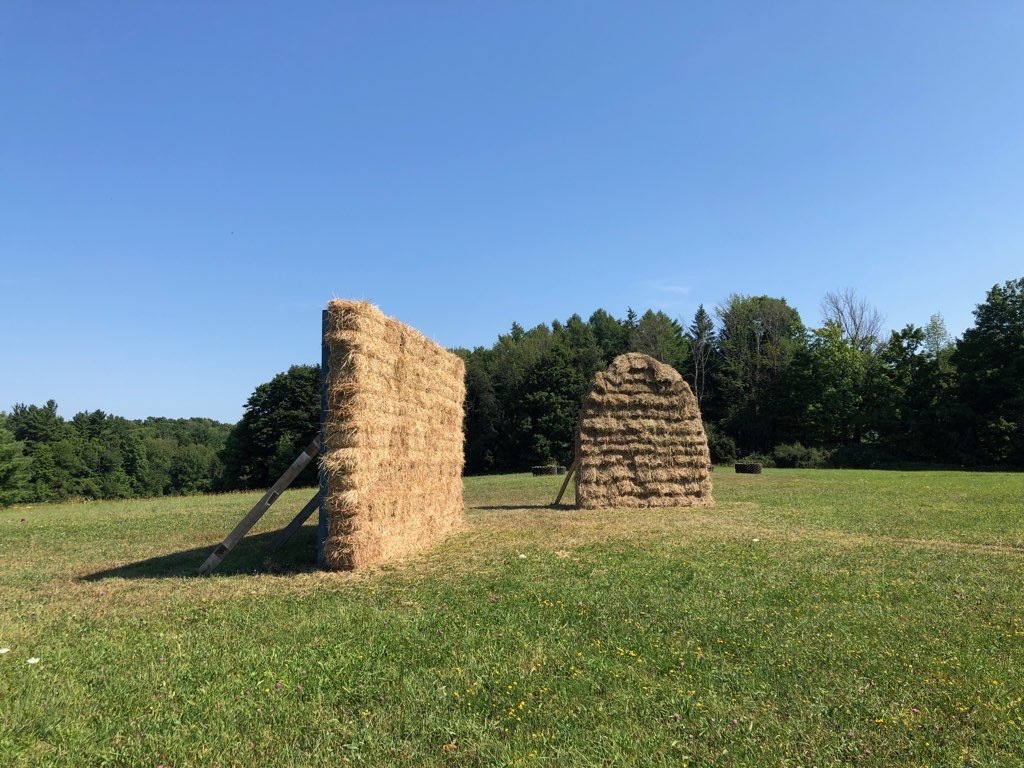
Anna Ialeggio, 2 DIFFRN’T HAYSTACKS, hay, reclaimed wood, baling twine, 2022
Sayward: 2 DIFFRN’T HAYSTACKS is both a sculptural installation and a participatory performance. How did this work come about?
Anna: My creation myth about this work, which is true to some extent, started when I was living in Los Angeles. I was leaving the city and getting to know the Owens River Valley, which is north of Death Valley. It’s in between two big mountain ranges, one of which is the Sierra Nevada, a very cinematic place: some of the tallest mountains in North America and then high desert sagebrush. The Owens River Valley is a watershed, based around the Owens River, and this thing that used to be called Owens Lake, which is now totally gone. It's kind of a famous environmental disaster. What happens when you drain an alkali lake? It turns into poison dust.
I would drive up the Owens River Valley and try to pay attention to when I would stop seeing signs that said, ‘This watershed belongs to the Department of Los Angeles Water and Power.’ The department has been diverting all kinds of rivers towards the city for a very long time, which is why Owens Lake is drained.
Anyway, you don't stop seeing those signs until you get up near Bishop, which is a 6-hour drive. It's quite a fragile landscape, a watershed draining out of the snow pack in the Sierra Nevada. These kinds of locations in the West are different from the East because the climate is great for year-round crops, but it depends on access to watersheds for irrigation. People are growing all sorts of amazing things but they have to irrigate. A lot of hay is grown out West. It's interesting to me that water shortages in California produce booms. The less water there is, the more money there is to be made growing water intensive crops, just a terrible inverse relationship. In the Owens River Valley, and in many other watersheds, the crop that is the cheapest to grow with the biggest return is hay. And it's highly political. This is the part of the country where you see signs that say things like “Dams mean food.” The message is not incorrect, it's just that the scale of it is wildly unsustainable, and only propped up by massive 100-year-old irrigation projects, which are based on historic inequities and are starting to fall apart.
That's a long way of saying that I was just driving around the area, and I saw this absolutely gigantic haystack made from really big bales, 4ft by 4ft. They were huge.
Sayward: And the bales are made by a specific piece of machinery? Did you encounter one large bale or a big expanse of hay bales?
Anna: They’re made with an industrial baler. I encountered a wall of hay bales. It’s a scale of hay that we don't really have in the East. The hay out West is usually grown on land that the farmer doesn’t own; it's usually public land leasing. So, public land rented very cheaply with grandfathered-in water rights. Farmers have been able to get by by growing something that is out of scale with the climate. Land use management in the West is not on a human scale.
This hay bale was the biggest one I'd ever seen, and someone had tacked a hand painted sign to it that said ‘The Donald’ because this was in 2015. It kind of staggered me. I started thinking of hay as an indicator about water policy and historical water rights. But seeing the sign, I shifted to thinking about how haystacks could align with cultural and political affinities. Particularly, I thought it was so amazing that this hay bale had basically been deployed as a billboard. I’ve had that image in my head for years. Additionally, around the same time, some politician I heard speak in an interview repeatedly said, “That is flat not true.” Which also stuck in my head.
Sayward: That’s not a saying, right?
Anna: It’s not a saying. So this project is the haystacks as a billboard and that phrasing as the scaffolding of ideology. I put them together and over time they’ve grown into two flat haystacks that are having a dialogue. Then it took on shades of “What is the dialogue that they're having?”
Inevitably, the dialogue is about form and function.
Sayward: Are the sculptures a dialogue of different technologies used in hay production and a variety of images of hay? Or perhaps, they ask what is identifiable as a hay bale?
Anna: A unit of hay. Yeah, I got really into thinking about how with the tufted, round old-fashioned stack, the unit of hay can only be determined by what a person can pick up.
Sayward: I think that person-scale relates to the scale of agriculture you encountered in the West that is way beyond the human scale.
Anna: It is. It is outside of a human scale, but then also giant vistas and huge watersheds draining into this one field. And then one person in an air-conditioned tractor that's two stories tall, driving around. They've made this prosthetic for themselves to be back in scale with the agriculture and landscape. It's very weird.
Sayward: How did you make decisions about the size of the sculptures?
Anna: They're determined by the units of hay and then by my capacity— well I didn't know what my capacity was
— I imagined what it would be like to lift the bales. So, I did some math. Then I met Randy Nash and he told me what kind of bailers he had, and then I tried to imagine myself picking up 50-100 bales of different sizes and stacking them. It’s also about what a human form that’s about 5ft 6in looks like in relation to a giant rectangle. It's a figure-ground relationship.
Sayward: As you were making the work, were there surprises and changes in your conceit?
Anna: Yes, I didn't know that I would like the scaffolding supporting the hay bales so much. I thought that I would probably enjoy building it because I didn’t plan how I would do that at all. I think I said offhandedly, one day to Stone Quarry's CEO Emily, ‘Oh yes, I will use willow because it's bendy and I'll make a frame.” It was a totally untested process. I followed through on it as best I could. That was inherently a surprise because I didn't really know how it was going to work! Also, it was such a surprise to have willow growing at Stone Quarry. It was so nice to be able to cross the field and get more willow when I needed to.
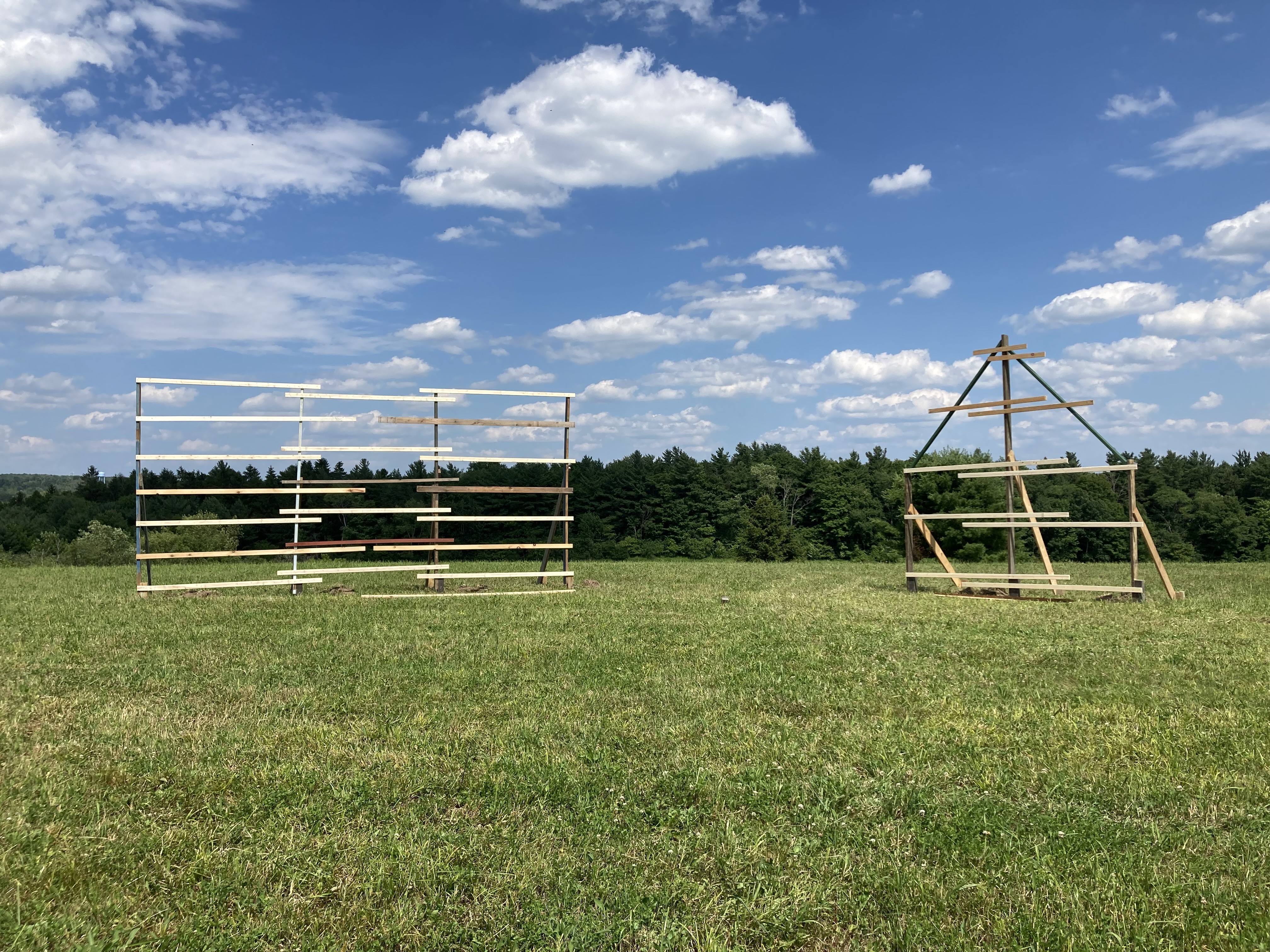
2 DIFFREN’T HAYSTACKS, an in-progress image of the scaffolding supporting the hay.
Anna: And, of course, the whole performance was a surprise.
Sayward: In the performance of 2 DIFFRN’T HAYSTACKS in late August 2022, you became your alter-ego “Garge,” an amateur ecologist, auctioneer, and yoga instructor. Garge invited, and perhaps, insisted, that people joined the performance. Were you inhabiting Garge while building the sculptures?

"Garge"
Anna: It’s only in the last year or so that I've admitted that I'm basically Garge all the time. Especially when I teach. He is present in the way that I move and the language that I choose, the way I begin and end sentences. He's my public speaker role, but he had never spoken in any of the earlier performances. Garge was silent or had very limited verbal expression. This is the first time he talked so much. And then inevitably, in the 2 DIFFRN’T HAYSTACKS performance, as he was talking, I realized he was actually 17 or 18 people.
Sayward: The performance was about an hour, and visitors gathered in the field near the sculptures. Garge gradually pulled us into an agreement to play along. Can you talk about the co-creation of the work, and how you invited viewers to become participants? I think that's somewhat central in your work, perhaps?
Anna: I think co-creation is central to my work. I suspect that my impulse is adjacent to the Theater of the Oppressed: if the audience is a participant with me, then we're able to look at the superstructure of performance, the space of performance itself, together. It's a very simple thing, but it's endlessly interesting to me.
The last performance I did just before covid was a performance where the audience was watching me watch a person pretend to be a bird, a kind of two layered bird watching. The audience was completely participating in the performance, and I believe that they understood that about the watching of the watching. That's a very literal version of looking at the superstructure of performance together. I've done many other performances where people are much more active participants.
Sayward: In that performance, everyone is participating by mutually agreeing that they are watching someone pretend that this person is a bird.
Anna: Yes, and they were also watching a very beautiful dancer in very tight tights move beautifully! There's a version of performance where it slides over the illusion and we dropped the 4th wall even though I might not look at you directly or acknowledge you. I'm pretty sure that you can see me myself, but also this character or role that I've put on. And you can see both at the same time, and you understand how that's working. And that is a form of participation.
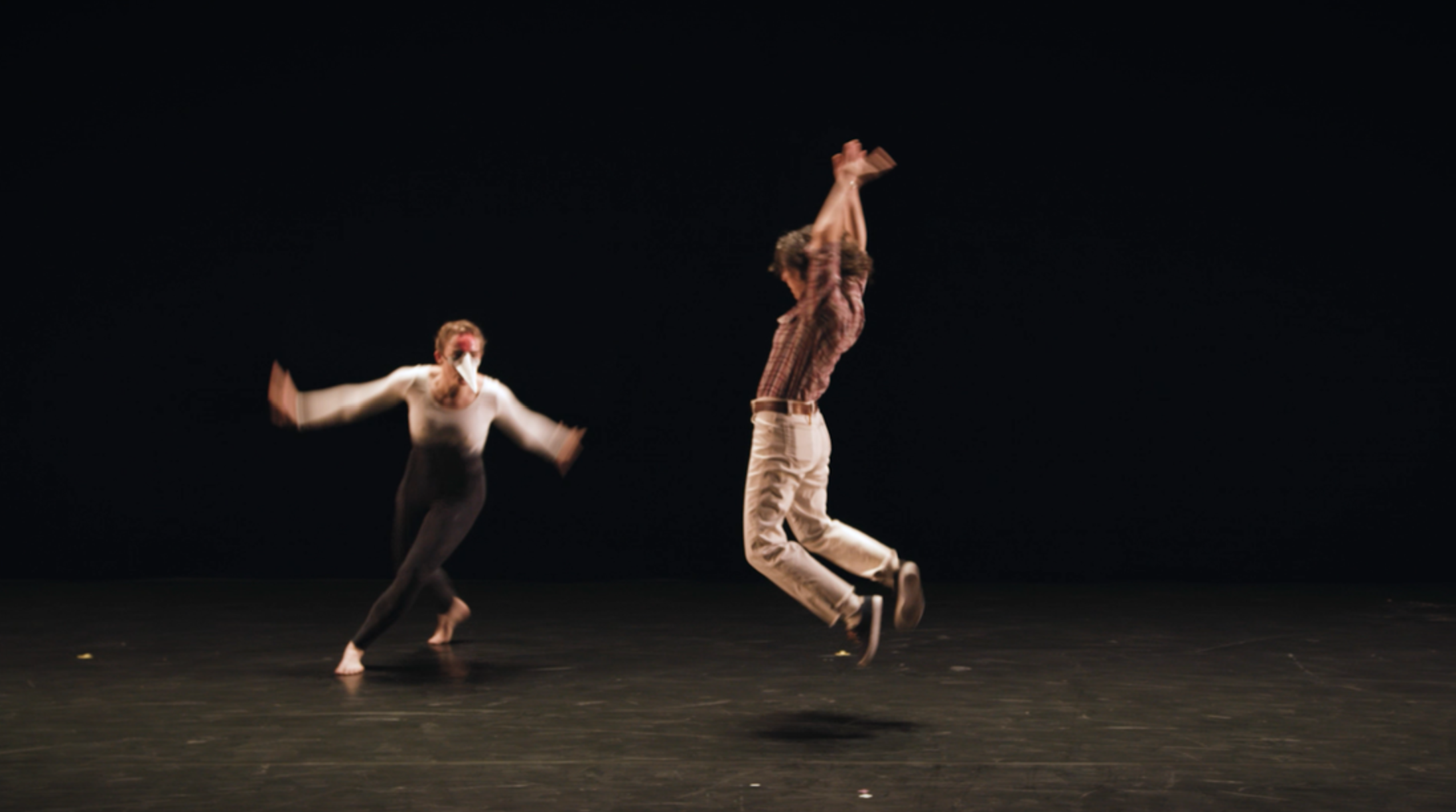
Still from Ialeggio's 2020 performance work Crane & Man
Sayward: Because you, the viewer, become self-aware that you’re part of the performance. Correct me if I’m wrong but it kind of feels like the opposite of the notion of getting lost in an artwork, or that you can be lost in an artwork, but there's always that moment where you notice yourself noticing.
Anna: Yeah, exactly. Especially when it's long! In the haystacks performance, I really wanted a very jolly version of willful self-implication. And part of that was, well, I always feel like if someone has decided to drive a long distance to see something that I'm doing, I should really give them their drive’s worth!
Sayward: By self-implication, do you mean you're trying to make the audience aware that you're very aware that you have created a scenario?
Anna: Yes. In the beginning, with 2 DIFFRN’T HAYSTACKS, everyone seemed content to stay by the road and watch me lug the bale of hay, get on top of it and say something. Then, I started demanding that people do things and bring me things. That was way to say I'm going to ask you into this performance. It's that you come over here and stand in this field with me. And then, anything that I do, you will be doing that with me.
Sayward: I think that there’s not always the same generosity in some performer-audience relations. The way of saying that we're in this performance together.
Anna: I really love that “this is what we're in together” feeling.
Sayward: I do, too.
Anna: It makes it so clear that going to see something is really important and an active thing to have done.
Another thing I’ve been thinking about for this project is the “magisterial view." Basically the idea that the landscape painting of the Hudson River School, the kind of representational landscape painting that was popular at that time, can be directly linked to surveying, land acquisition, and the feeling of ownership over something based on it having a good view. That idea of ownership is implicit in American land use. It defines the oblique relationship of the two hay bales. There's a vanishing point perspective between them with a Vista beyond, and there's figures in relation to that. The magisterial view also informs why I was constantly trying to be higher than everyone in the performance by standing on hay bales. Then, the auction within the performance is the natural side effect of surveying: once you have defined something that you may like, once you know the edges of the thing, then you can sell it. And, of course, you go and sell it. That relationship between art and surveying and auctioning— there's so much weirdness in there!
Sayward: And the term survey is used both in art history and land management! You have an art survey class, for example.
Anna: An art survey class bestows ownership over some form of ultra-literacy.
Sayward: Yes, a grand story of art.
Anna: And your place within it. The act of standing on top of a makeshift hay bale podium is the ultimate performance of recreation, rugged individualism, and acquisition.
Sayward: You standing on the hay bale podium was your Caspar David Friedrich moment! This very precariously-made podium.
Anna: Yes, I needed people to hold it up for me! An auction is kind of the ultimate, perverted version of a participatory performance, which is that you are participating, and you do have agency, but the whole thing is designed to lull you into a competitive trance state and to buy things that you did not intend to buy. I like how those things do and undo each other.
Sayward: After the building of the makeshift podium and the auction, where the land parcels you designated had been purchased, you identified a gore. You explained to the group that a gore was an unclaimed piece of land made by way of surveying error. Meanwhile, two groups of people led by the land purchasers are synthesizing the culture of their plots, and you’re rolling through all the identities of Garge, offering conflicting advice on what to do with the gore: to sell it, to keep it, to develop it. In the midst of figuring, Garge, in a trickster fashion, ultimately leads everyone into this yoga practice that left me with a marvelous feeling of “Oh. No.” After the auction, I had a sense that everyone wanted to move toward a communal sharing of the gore and subvert the norm of land ownership. Garge set us up to subvert, and then the subversion ultimately culminated in a culturally appropriated commercialized exercise practice.
Anna: The myth of self-improvement.
Sayward: So well done.
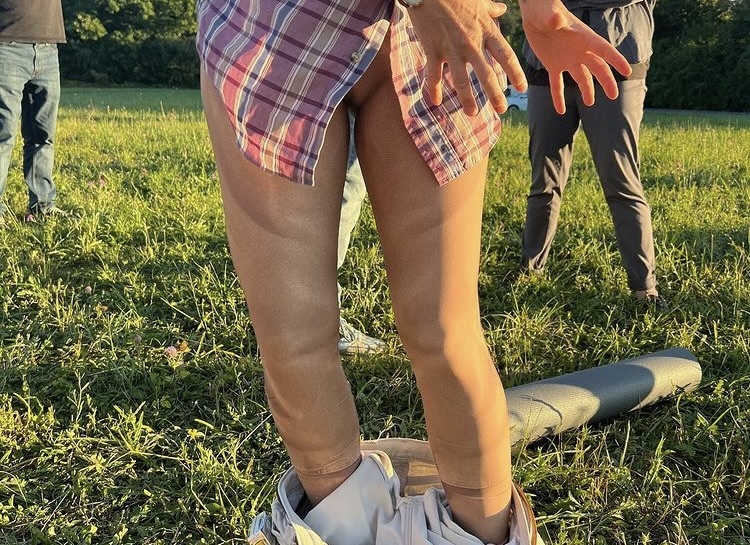
Garge changes to yoga pants to lead participants into an impromptu yoga class.
Anna: Jo Freeman wrote this wonderful piece called “The Tyranny of Structurelessness.” It’s about radical feminist collectives in the 60s/70s that attempted to subvert all the old ways by rejecting them utterly. The only problem is that if you reject all the containers utterly, then what you bring to the potluck is your baggage. And so that's the tyranny of structurelessness: without an intentional container for something new to be developed, you end up reenacting all of the things that you despise most.
Sayward: You did create a container in the performance. I know it's very clear that you had the performance in your brain but that the outcome was never certain. Could you talk about the connection between creating that container, and what you said at the conclusion of the performance when we were laying in the field waiting for pizza? As we laid in our post-yoga postures, you acknowledge that we were on the unceded lands of the Haudenosaunee Confederacy. You’ve mentioned that you address serious and grave issues through certain kinds of playfulness and levity. Is that always part of the container you're trying to create?
Anna: It's definitely part of my tendencies. I have always wondered what it would be like to try and make something real straight ahead. I fantasize about that sometimes. Just like, “I'm just here to make something beautiful! No other agenda here!” But I don't seem to be able to.
The container is an organizational strategy because of my clowning training. Here's an example from when I was in high school. We did mock trials and I lobbied really hard to be the prosecuting attorney, and my justification was that I had a really good blazer. It was very pointy. So I got the job, and the role inflamed everything in me that was most complicated and most enjoyable all at the same time, which included making obsessive, absurd flow charts of how I would twist the answers to every question towards my aim. Crazy flowcharts that were designed to unravel everything. I became this procedural performative character that has been present in me ever since, which is this entity who walks in and says, “You all know me. You know exactly why I'm here.” And then nobody does know why, and then the character totally unravels. Which is exactly what happened during the mock trial.
Sayward: Meaning that you unraveled, not everyone around you?
Anna: Yes, I unraveled. I became a pile of string.
Sayward: That experience predates your introduction to clowning?
Anna: I just had this way of being confused by performance that I liked and really didn't know what to do with. In 2013, my friends got married and instead of gifts they asked all their friends to give them a performance at the reception, which is such a great idea. At that time, I had this character who was a cactus. I 100% thought of them as a cactus. The cactus had mostly just been in some sort ho-hum videos where they wandered around and were confused by things. I didn't really know who they were. And so, I thought I'll just put on the cactus and sing a song and that'll be good enough. I decided to sing the Patsy Cline song “Walking After Midnight.” My cactus costume wasn’t long enough to cover my feet, and I felt strongly that no one should see my feet. But there was no backstage at the reception, so I went behind a bush that was maybe 100 feet away. I walked all the way to the stage, crouched because I was very committed to this idea that no one should see my feet. And of course it took way longer than I thought to walk, and everyone just watched me. I got on stage and I couldn't reach the microphone without standing up and revealing my feet, so I had to ask someone to help me get the microphone. Then, I sang Patsy Cline, and then couldn't put the microphone back on the stand. Then I had to walk all the way back to the bush. The Mother of the bride came up to me afterwards and exclaimed, “That was so beautiful. You were the most beautiful pickle.”
My now friend Caitlin, who I didn't know at that time, bee-lined for me and said, “Did you know that you're a clown?" That was the beginning of clowning for me.
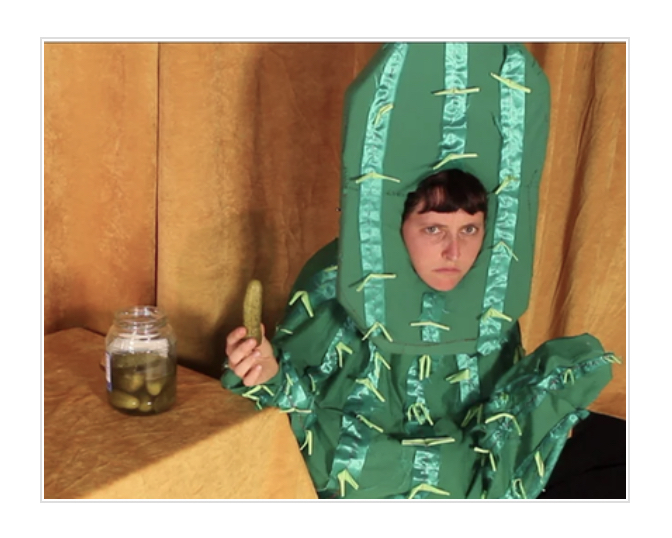
Sayward: Then what did you do?
Anna: Well, after Caitlin said that, I thought about it fearfully for a few years. Then I found a clown school. Within two years, I rejected all of their rules and disagreed with all their principles and all their practices and all their traditions. Then Caitlin and I started our own clown school. Then covid hit.
Sayward: For those who know little about clowning: What are three principles of clowning?
Anna: That's such a good question. I think they've already popped up in this conversation. The first one is that a clown doesn't really recognize in their purest expression the agreed upon conventions of performance. They are constantly pointing out, “Do you see what's happening between us? It's very weird. I need you to respond to me and I cannot exist without you.” So there's this give and take with clowning where you’re locked into this thing together. The second thing is that clowns recklessly express how they really feel. So if you're trying to get into your clown self, what you're trying to do is very scary: to get to a place where you can actually show how you truly feel as recklessly and as rampantly and fully as you can, but to still be slightly aware in part of your brain. Aware that you can shape it and that it is a game. The third thing is, I think, that clowning's mode of expression is play.
Sayward: Can you tell me one thing you rejected from your clown academy experience?
Anna: Yes. A big part of clowning is based on a couple of French clowns who are brilliant, like the Lecoq method. I went all in on this method because it gave me practice with being told, repeatedly and firmly, NO. So, in this method of training, you get destroyed. You are taken fully apart, and then you have to find a way to put yourself back together. And while that was what I wanted at that moment, I came to feel that that was not the only way into a world of play and poetry, and that there were more accessible ways for people who have different kinds of trauma in their lives or being. Ultimately, I came to feel that most men should do the form of clowning where they get torn down and told NO a lot, and that everyone else could do something else!
Sayward: I didn't know about the tradition of NO in clowning. It reminds me of the inverse YES AND of improvisation, and that the repeated NO and the YES AND are perhaps both troubling approaches.
Anna: They both lock you into a relationship with the audience where you're at their mercy, and also at the mercy of whoever you're playing with.
Sayward + Anna: But that's not actually how play works!
Anna: The clown is the master of NO, full stop. And then if the clown feels like it, “NO, but I'm going to do this now.” I also disagreed with clowning teachings with the emphasis on being funny and always trying to find a way towards funniness. To me, everything and everyone is already funny! What we need help with is being honest and feeling safe: that’s how I wanted to teach and practice clowning because if you feel safe, then you can be weird, and then everything is funny. If you try to be funny without safety or trust, then there's a lot of relying on agreements that no one actually agreed to, and many of those agreements are really hurtful.
Sayward: I’d imagine that we accidentally or purposely draw from culturally absorbed constructs of what funny is, which often draws upon hurtful stereotypes.
Anna: Yes, and at the expense of something or someone.
Sayward: Yes, using a person or group to create a counterpoint or an othering of a “norm.” Did you notice distinct changes or revelations in your artistic practice once you became a clown?
Anna: It started happening as soon as I started. Here’s the thing. You can clown on your own, but it’s really about the relationship with another person or an audience: the space in between you and the audience is key. You just decide as a clown or as a person that you will now show yourself, not a curated version. Whatever that's like, that's what the clown is. You reveal. You choose to reveal. The moment that I realized that it is a choice, the art I was making started to really, really change. Clowning also gave me a concrete way to talk about the collaborative play of my work in different terms.
Clowning has made me good at seeing other people who are clowns, and then asking if I can please hang out and make stuff with them. It’s an incredibly precise social life orchestration tool. That’s how I found my collaborator for the bird watching performance.
Sayward: You realized that you’re a clown sculptor.
Anna: I realized that I could have a deep play in the studio part of my art practice, that I could play materially. I had been kind of hung up on the pursuit of mastery for a long time. I did many apprenticeships with master craftspeople, woodworking, ceramics. Suddenly, I could really play. I had been relying on a weird sense of humor to cover up the fact that a lot of my projects were super half-baked.
Sayward: Have you come to embrace the half-baked idea?
Anna: Yeah, absolutely. I trust myself more. I'm comfortable with an artistic process where I feed something to my lizard brain and forget about it for two to five years. There's a million modalities of this process; I was lucky enough to bungle into one (clowning) that is well suited to me. That's the coolest part about getting older. In your art practice especially, you realize that all of the systems are touching.
Sayward: The notion of systems touching over the years reminds me of an anecdote from my brilliant friend Maria Robinson. She says, “Every artwork is a lifetime work,” meaning that every work an artist makes draws from a lifetime of questioning, playing, connections, systems.
Anna: I love that. That's wonderful. I certainly feel that way about 2 DIFFRN’T HAYSTACKS! I'm so grateful that I've gotten it out of my brain and body. Now I just want to do it again! What's fascinating about making something site specific is that I did not make a reproducible unit of artwork. What would happen if I tried to recreate this, go through this process on another site, in another place, maybe under different conditions? I'm curious about that. That's, to me, the promise and curse of a performance score. The score promises continuity, though you might lose the element of surprise for yourself. So, I skew hard towards improvisation and new things because I’m addicted to trying to find surprise.
Sayward: Iterate something to see what's new and surprising. You can encounter the same objects again and again, and with different people, gatherings, and points of view, they are never the same.
Anna: There’s so much narrative raw material. The narrative and the sculptures site each other. I can imagine a million kinds of programming I want to try because the sculptures can also act like billboards, film sets, roadside attractions…
Sayward: From this conversation I think we could make a recommended reading on the history of agriculture and clowning!
Anna: Keith Johnstone’s Impro is a great improvisation book. I've been piecing this together for a long time, and a lot of it is driving around talking to people. Sure, there are some really good books. But yeah, this is just my spin on it. Who knows if it's a fact, but it's my perception of a fact. Wow, those are good clouds.

